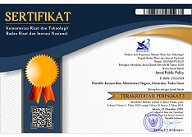Penerapan Teknologi Blockchain Dalam Perspektif Akuntansi, Apakah Tepat Guna?
Abstract
Keywords
Full Text:
PDFReferences
Ahmad, A., Wahyuni, I. S., Istiqomah, L., Wulan, E., & Tiyas, W. (2022). Triple Entry Bookkeeping di Era Teknologi Blockchain: Suatu Kajian Literatur (Vol. 10, Nomor 3).
Akter, M., Kummer, T. F., & Yigitbasioglu, O. (2024). Looking beyond the hype: The Challenges of Blockchain Adoption in Accounting. International Journal of Accounting Information Systems, 53. https://doi.org/10.1016/j.accinf.2024.100681
Amar, K. (2012). Six Sigma Frameworks: An Analysis Based on Rogers’ Diffusion of Innovation Theory.
Aruna Sri, P. S. G., & Lalitha Bhaskari, D. (2021). A Blockchain Framework for Healthcare Data Management Using Consensus Based Selective Mirror Test Approach. Dalam Blockchain Technology: Applications and Challenges (hlm. 77–95). https://doi.org/10.1007/978-3-030-69395-4_5
Bandaso, T. I., Randa, F., Faradilla, F., Mongan, A., Kristen, U., Paulus, I., Atma, U., & Makassar, J. (2022). Blockchain Technology: Bagaimana Menghadapinya? - dalam Perspektif Akuntansi. Accounting Profession Journal (APAJI), 4(2).
BNI. (2018, Mei 11). Manfaatkan Teknologi Blockchain, BNI Tingkatkan Bisnis Trade Finance dan Remittance.
Derbali, A., Jamel, L., Mani, Y., & Al Harbi, R. (2019). How Will Blockchain Change Corporate Governance? International Journal of Business and Risk Management, 2(1), 16–18. https://doi.org/10.12691/ijbrm-2-1-3
Giffari, A., Hubeis, M., & Sukmawati, A. (2023). Faktor-faktor yang Memengaruhi Organisasi dalam Mengadopsi Teknologi Blockchain di BPJS Ketenagakerjaan. Jurnal Aplikasi Bisnis dan Manajemen, 9(2). https://doi.org/10.17358/jabm.9.2.536
Grigg, I. (2024). Triple Entry Accounting. Journal of Risk and Financial Management, 17(2), 76. https://doi.org/10.3390/jrfm17020076
Haber, S., & Stornetta, W. S. (1991). How to Time-Stamp a Digital Document. Journal of Cryptology, 3, 99–111. https://doi.org/10.1007/BF00196791
Harahap, E. P., Aini, Q., & Anam, R. K. (2020). Pemanfaatan Teknologi Blockchain pada Platform Crowfunding. Dalam Technomedia Journal (TMJ (Vol. 4, Nomor 2).
Hartoyo, A., Sukoharsono, E. G., & Prihatiningtyas, Y. W. (2021). Analysing the Potential of Blockchain for The Accounting Field in Indonesia. Jurnal Akuntansi dan Keuangan, 23(2), 51–61. https://doi.org/10.9744/jak.23.2.51-61
Heryanta, J. (2019). Pengaruh Behavioral Intention Terhadap Actual Use Pengguna GO-JEK Indonesia dengan Pendekatan Technology Acceptance Model dan Innovation Diffusion Theory. Jurnal Ilmiah Mahasiswa FEB, 7(2).
Houdet, J., Ding, H., Quétier, F., Addison, P., & Deshmukh, P. (2020). Adapting double-entry bookkeeping to renewable natural capital: An application to corporate net biodiversity impact accounting and disclosure. Ecosystem Services, 45, 101104. https://doi.org/10.1016/j.ecoser.2020.101104
Ijiri, Y. (1982). Triple-Entry Bookkeeping and Income Momentum (Vol. 18). American Accounting Association. https://gwern.net/doc/bitcoin/1982-ijiri-tripleentrybookkeepingandincomemomentum.pdf
Jena, A. K., & Dash, S. P. (2021). Blockchain Technology: Introduction, Applications, Challenges. Dalam Blockchain Technology: Applications and Challenges (hlm. 1–11). https://doi.org/10.1007/978-3-030-69395-4_1
Kurniawan, A., Wulandari, W. A., Saragih, R. E., & Verdian, I. (2019). A Review of Blockchain: How Does It Work, Applications, and Challenges. Journal of Telematics and Informatics, 7(2), 69–79. https://doi.org/10.12928/jti.v7i2.
Luthfiyyah, Z., & Dewayanto, T. (2023). Implikasi Blockchain Pada Kecurangan Akuntansi: Telaah Literatur Sistematis (SLR). Diponegoro Journal of Accounting, 12(4), 1–15.
Marzali, A. (2016). Menulis Kajian Literatur. Jurnal Etnosia, 1(2), 27–36. https://doi.org/10.31947/etnosia.v1i2.1613
Mougayar, W. (2016). The Business Blockchain (1st ed.). Wiley.
Mukherjee, P., & Pradhan, C. (2021). Blockchain 1.0 to Blockchain 4.0—The Evolutionary Transformation of Blockchain Technology. Dalam Blockchain Technology: Applications and Challenges (hlm. 29–49). https://doi.org/10.1007/978-3-030-69395-4_3
Nabila, M. (2018). BCA Klaim Sudah Mulai Terapkan Teknologi Blockchain. DailySocial.
Nakamoto, S. (2008). Bitcoin: A Peer-to-Peer Electronic Cash System. www.bitcoin.org
Nugraha, I., & Sutopo, W. (2018). Perkembangan Teknologi Blockchain Dalam Traceability System: Studi Kasus Penelitian Terindeks Scopus. Seminar Nasional Sains dan Teknologi.
Okada, H., Yamasaki, S., & Bracamonte, V. (2017). Proposed Classification of Blockchains Based on Authority and Incentive Dimensions (hlm. 19–22).
Oktavian, D. P. (2022). Jagoan Trading Crypto (H. Arifin, Ed.). Media Pressindo.
Ongaro, D., & Ousterhout, J. (2003). In Search of an Understandable Consensus Algorithm. USENIX ATC ’14: 2014 USENIX Annual Technical Conference, 338.
OnlinePajak. (2018, Oktober 4). Blockchain dan Pemanfaatannya di Indonesia. https://www.online-pajak.com/tentang-pajak/blockchain
Pedersen, A. B., Risius, M., & Beck, R. (2019). A Ten-Step Decision Path to Determine When to Use Blockchain Technologies. MIS Quarterly Executive, 18(2), 99–115. https://doi.org/10.17705/2msqe.00010
Pratiwi, L. L. (2022). Implementasi Blockchain Pada Akuntansi dan Audit di Indonesia. Fair Value: Jurnal Ilmiah Akuntansi dan Keuangan, 4(6).
Rahmawati, M. I., & Subardjo, A. (2022). A Bibliometric Analysis of Accounting in the Blockchain Era. Journal of Accounting and Investment, 23(1), 66–77. https://doi.org/10.18196/jai.v23i1.13302
Ramadhani, A., Ananda, D. A., & Azmi, Z. (2024). Teknologi Blockchain dan Sistem Akuntansi: Potensi dan Tantangan. Indonesian Journal of Economics, 1(1), 37–48.
Rizal, M. R. S., Roni Andarsyah, & M. Yusril Helmi Setyawan. (2023). Optimizing Blockchain Network Creation: Automation with Ansible on Private Blockchain Hyperledger Fabric Using Simplified RAFT Consensus Method. Journal of Informatics and Telecommunication Engineering, 7(1), 340–355. https://doi.org/10.31289/jite.v7i1.10035
Rogers, E. M. (1983). Diffusion of Innovations (3th ed.). Free Pass.
Rogers, E. M. (2003). Diffusion of Innovations (5th ed.). Free Press. https://books.google.co.id/books?id=9U1K5LjUOwEC&printsec=frontcover&hl=id#v=onepage&q&f=false
Sari, A. N., & Gelar, T. (2024). BLOCKCHAIN: TEKNOLOGI DAN IMPLEMENTASINYA. Jurnal MNEMONIC, 7(1), 63–70. https://doi.org/10.36040/mnemonic.v7i1.6961
Schollmeier, R. (2001). A Definition of Peer-to-Peer Networking for The Classification of Peer-to-Peer Architectures and Applications. Proceedings - 1st International Conference on Peer-to-Peer Computing, P2P 2001, 101–102. https://doi.org/10.1109/P2P.2001.990434
Sekaran, U., & Bougie, R. (2016). Research Methods for Business: A Skill Building Approach (7th ed.). John Wiley & Sons Ltd. www.wileypluslearningspace.com
Strauss, A., & Corbin, J. (2003). Penelitian Kualitatif. 158–165.
Sugiyono, S. (2013). Metode Penelitian Kuantitatif, Kualitatif, dan R&D. Alfabeta.
Swan, M. (2015). Blockchain: Blueprint for a New Economy.
Triantonno, T., & Firmanto, Y. (2019). Analisis Penerapan Blockchain Dalam Rangka Pencegahan Accounting Fraud.
Wardhani, D. K., Sawarjuwono, T., & Budisusetyo, S. (2022). Blockchain in Capital Markets: A Revolution of the Trading System in Stock Exchange. The Indonesian Accounting Review, 12(1), 1–16. https://doi.org/10.14414/tiar.v12i1.2437
Wild, J., Arnold, M., & Stafford, P. (2015, November 2). Technology: Banks Seek the Key to Blockchain. Financial Times. https://www.ft.com/content/eb1f8256-7b4b-11e5-a1fe-567b37f80b64
Winarko, B. (2022). Tinjauan Beberapa Model Teori Dasar Adopsi Teknologi Baru. Media Bisnis, 5(1), 24–34.
Yermack, D. (2017). Corporate governance and blockchains. Review of Finance, 21(1), 7–31. https://doi.org/10.1093/rof/rfw074
DOI: https://doi.org/10.35308/akbis.v8i2.9530
Refbacks
- There are currently no refbacks.





